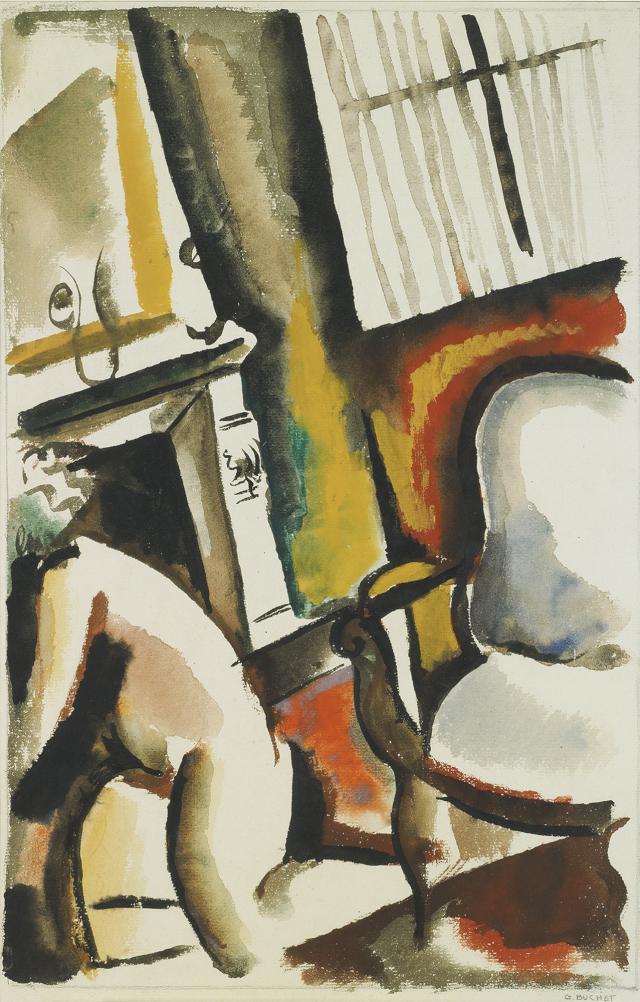These two watercolours, which were probably done in the second half of Gustave Buchet’s career, show a return to stylistic characteristics that he had developed very early on, i.e., a fragmentation of form and a subordination of colour to line. But here Buchet is a far cry from the pared-down aesthetic of his early years, which focused on objects and was devoid of the anecdotal. Rather, he turns out two picturesque scenes in just a few brushstrokes.
Although he passes through the most radical movements of pictorial modernity, Buchet will never resign himself to banishing sensibility from his art. He describes his painting in these terms, “A surface animated by my joy and emotion”. Moreover, in the 1930s, Buchet reintroduces modelling and an academic approach into his compositions whilst lavishing great care on the atmosphere that pervades his works, “1930: …I have the impression I’m in a dead end whilst remaining obsessed by the desire to express myself, and something more human. Prudent return to the notion of atmosphere, presence of intermediary pictorial planes.” It is the human figure that makes it possible for him to introduce these notions of atmosphere and emotion.
In La Lecture (Reading), a nude woman is reading, seated across an armchair. In the second scene, another naked woman is rising and appears to be slipping out of the composition. For both situations, the artist plays with the formal contrast of the body’s curves, which stand out against a background that is built up from geometrical lines. Paul-André Jaccard explains the artist’s decision here, “His originality [lies] in this dynamic interaction between order and emotion, the strict construction in rectilinear planes and the celebration of rounded forms – evocation of a woman or mere formal element – between the intellectual and the sensual, a strange balance that in Buchet’s character enabled the man to be both mystical and a bon vivant, reasonable and passionate”.
In the construction of the two watercolours, a spatial imbalance is caused by the presence of numerous diagonal lines which are underscored in black. This upending of the ground and the dynamic it creates recall Buchet’s fondness for transcribing movement. The limited range of colours and the technique employed also allow the artist to animate these compositions with quick light brushstrokes.
Although he passes through the most radical movements of pictorial modernity, Buchet will never resign himself to banishing sensibility from his art. He describes his painting in these terms, “A surface animated by my joy and emotion”. Moreover, in the 1930s, Buchet reintroduces modelling and an academic approach into his compositions whilst lavishing great care on the atmosphere that pervades his works, “1930: …I have the impression I’m in a dead end whilst remaining obsessed by the desire to express myself, and something more human. Prudent return to the notion of atmosphere, presence of intermediary pictorial planes.” It is the human figure that makes it possible for him to introduce these notions of atmosphere and emotion.
In La Lecture (Reading), a nude woman is reading, seated across an armchair. In the second scene, another naked woman is rising and appears to be slipping out of the composition. For both situations, the artist plays with the formal contrast of the body’s curves, which stand out against a background that is built up from geometrical lines. Paul-André Jaccard explains the artist’s decision here, “His originality [lies] in this dynamic interaction between order and emotion, the strict construction in rectilinear planes and the celebration of rounded forms – evocation of a woman or mere formal element – between the intellectual and the sensual, a strange balance that in Buchet’s character enabled the man to be both mystical and a bon vivant, reasonable and passionate”.
In the construction of the two watercolours, a spatial imbalance is caused by the presence of numerous diagonal lines which are underscored in black. This upending of the ground and the dynamic it creates recall Buchet’s fondness for transcribing movement. The limited range of colours and the technique employed also allow the artist to animate these compositions with quick light brushstrokes.
